
Today’s blog about sinks and traps is not about plumbing …
Last week Michelle Kienholz noticed that the mockingbird family near her office was under predation pressure again. In June half the family was eaten by a red-tailed hawk. On Friday two flightless young were frightened to the ground. Michelle put them in a thick bush and hoped for the best. I thought to myself, “That place is a biological sink for mockingbirds.”
Like a sink hole, shown at top, a biological sink is where a species breeds but the habitat works against them so they always fail to produce enough young to replace themselves. The population sinks at that site.
A sink can be offset by a high quality habitat called a biological source where the population more than replaces itself. If the sources equal the sinks the population remains stable. If the sources outweigh the sinks the population grows. This balancing act is called source-sink dynamics.
Sometimes a sink is so attractive to breeders that they’re drawn to it in large numbers even though they always fail. These ecological traps cause localized population crashes.
A good example of an ecological trap is the effect that outdoor lights have on mayflies.
Mayflies lay their eggs on water, often at night. To find water in the dark they look for the polarized light reflection of the moon on water. Unfortunately, our outdoor electric lights are like thousands of moons that reflect off artificial polarizing surfaces — asphalt, cars, windows, etc. The mayflies mistake these false surfaces for huge bodies of water and land there to lay eggs. The locations are both sinks and traps. All the mayfly eggs are wasted.

The number of mayflies that fall for these traps can be astonishing. In June 2015 in Wrightsville, PA on the Susquehanna River, there were so many mayflies on the Route 462 bridge that the surface became slippery with dead mayfly bodies. They had to close the bridge.
I suspect that if they’d turned off the streetlights while the bridge was closed, the trap would have disappeared, the mayflies would have gone elsewhere, and there would have been less to clean up.
(credits: video from WGAL-TV via YouTube. photo of car with mayflies by Rona Proudfoot on Flickr Creative Commons license. All other photos from Wikimedia Commons. Click on the images to see the originals)

Thanks. I hadn’t heard of the concept of sinks and traps before. I had heard the term “sacrificial nest site” in regards to Peregrine Falcon nest in a public area. These exposed nests are not necessarily expected to successfully raise young, but the opportunity to educate many members of the public is a primary motivator.